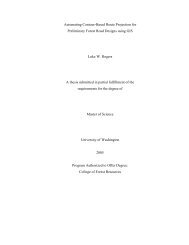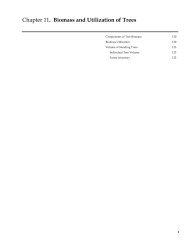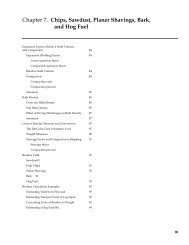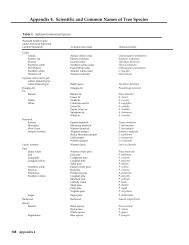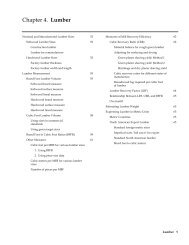Chapter 5. Veneer and Plywood - Rural Technology Initiative
Chapter 5. Veneer and Plywood - Rural Technology Initiative
Chapter 5. Veneer and Plywood - Rural Technology Initiative
Create successful ePaper yourself
Turn your PDF publications into a flip-book with our unique Google optimized e-Paper software.
<strong>Chapter</strong> <strong>5.</strong> <strong>Veneer</strong> <strong>and</strong> <strong>Plywood</strong>Measurement 68St<strong>and</strong>ard Reporting Basis 68Square foot 3/8 inch basisSquare meter, 1 mm basisImperial to metric conversion factorsU.S. Softwood <strong>Veneer</strong> <strong>and</strong> <strong>Plywood</strong> 68<strong>Veneer</strong> sheet thickness<strong>Veneer</strong> sheet width<strong>Veneer</strong> sheet length<strong>Plywood</strong> panel sizesVolume of veneer or panels1. Converting surface measureof any thickness to the3/8 inch basis2. Cubic foot calculation3. Cubic meter calculationHardwood <strong>Veneer</strong> <strong>and</strong> <strong>Plywood</strong> 70<strong>Veneer</strong> sizes<strong>Plywood</strong> panel sizesVolume of veneer or panelsRecovery Efficiency 72Material Balance Green-End Recovery 72From mill studiesTheoretical material balanceMaterial Balance Dry-End Recovery 74Recovery Efficiency Measures 74Cubic recovery ratio (CCR)<strong>Veneer</strong> recovery factor (VRF)Relationship between CRR <strong>and</strong> VRF<strong>Veneer</strong> recovery <strong>and</strong> board foot log scaleWeight of <strong>Veneer</strong> <strong>and</strong> <strong>Plywood</strong> 76<strong>Veneer</strong> <strong>and</strong> <strong>Plywood</strong> 1
<strong>Chapter</strong> <strong>5.</strong> <strong>Veneer</strong> <strong>and</strong><strong>Plywood</strong>MeasurementSt<strong>and</strong>ard Reporting BasisSquare Foot 3/8 Inch Basis (SF 3/8 ). In NorthAmerica, statistics on veneer, plywood, <strong>and</strong> otherpanel products (<strong>Chapter</strong> 6) are generally reported asthe number of square feet, or surface measure, of astated thickness. Due to the variety of thicknessesavailable, surface measures are not directly comparable.Hence to facilitate accounting <strong>and</strong> reporting,statistics are commonly expressed on a st<strong>and</strong>ardizedthickness basis. For veneer <strong>and</strong> plywood, thisst<strong>and</strong>ard thickness basis is 3/8 inch. <strong>Plywood</strong> <strong>and</strong>veneer volumes are usually measured dry (2 to 5%MCod).For other panel products, covered in <strong>Chapter</strong> 6,the st<strong>and</strong>ard thickness basis may be 1/8, 3/8, 1/2,or 3/4 inch depending on the category of panel.Table 5-1 lists a number of common panel thicknesses<strong>and</strong> factors to convert them to one of the fourst<strong>and</strong>ard thickness bases.Square Meter, 1 mm Basis. The st<strong>and</strong>ard basis forreporting plywood <strong>and</strong> veneer in countries on themetric system is the square meter, 1 mm basis. Thisrepresents a piece 1 m square <strong>and</strong> 1 mm thick, or1/1,000 cubic meter.Imperial to Metric Conversion Factors for<strong>Plywood</strong>. Table 5-2 presents commonly usedconversions.U.S. Softwood <strong>Veneer</strong> <strong>and</strong> <strong>Plywood</strong><strong>Veneer</strong> Sheet Thickness. Softwood veneerthicknesses usually range from 1/16 to 5/16 inch,with the most common being 1/10, 1/8, <strong>and</strong> 1/6inch. Thicknesses are often expressed by mills inthous<strong>and</strong>ths of an inch. The lathe setting is somewhatlarger to account for compression duringpeeling, peeling variation, <strong>and</strong> shrinkage duringdrying. Procedures to calculate the green targetthicknessat the lathe are similar to those for lumber explainedin <strong>Chapter</strong> 4 (pp. 58-59).<strong>Veneer</strong> Sheet Width. Assuming the common 4foot plywood panel width, veneer is manufacturedin the following nominal widths: 48 inches (full),24 inches (half), <strong>and</strong> strip (narrow strips abovea minimum salvage size, often 6 inches). Otherwidths may be produced to correspond to otherpanel sizes, as shown in Table 5-3. To allow forshrinkage of veneer during drying <strong>and</strong> trimmingof finished plywood panels, these widths areincreased to develop target values on machinery.Thus a mill's green clipper may produce full <strong>and</strong>half widths as 54 <strong>and</strong> 27 inches respectively. Actualpractice will vary from mill to mill basedon quality control <strong>and</strong> other factors.<strong>Veneer</strong> Sheet Length. When veneer is obtainedfrom a lathe, veneer length exceeds that of a finishedplywood panel. For example, on the common 8 footlathe, the veneer is initially about 100 to 104 incheslong. This oversize length allows for shrinkagewhen the veneer is dried <strong>and</strong> for panel trimming.The actual log (block) peeled is somewhat longerthan the length of veneer. <strong>Veneer</strong> lengthscorrespond to panel lengths shown in Table 5-3.The most common length is 96 inches (8 footplywood). Crossb<strong>and</strong> widths are half that length.The lineal footage of the veneer ribbon producedfrom a lathe can be estimated by dividing the squarefootage by the veneer length.<strong>Plywood</strong> Panel Sizes. Table 5-3 presents thedimensions of softwood plywood according to U.S.Product St<strong>and</strong>ard PS 1-83. The most commonlyproduced panel size is 4 by 8 feet in various thicknesses.Volume of <strong>Veneer</strong> or Panels:1. Converting Surface Measure of Any Thicknessto the 3/8 Inch Basis. To convert surface measureof veneer or plywood of some thickness (SMt) to the3/8 inch basis (see Example 1), divide the actualthickness (t) in inches by 3/8 inch (t / 0.375 inch)<strong>and</strong> multiply by the surface measure:SF 3/8 = SMt * (t / 0.375) = 2.667 * t * SM t.Column 4 of Table 5-1 lists values of t/0.37<strong>5.</strong><strong>Veneer</strong> is marketed on the basis of nominaldimensions; the square footage of 1/10 inch fullsheets is generally calculated on the basis of nominaldimensions such as 4 by 8 feet <strong>and</strong> excludes2
Table 5-1. Conversion of actual panel thickness to st<strong>and</strong>ard thickness basis.Actual Thickness Conversion to(in) (mm) 1/8 inch basis 3/8 inch basis 1/2 inch basis 3/4 inch basis(1) (2) (3) (4) (5) (6)1/8 3.18 1.0000 0.3333 0.2500 0.16673/16 4.76 1.5000 0.5000 0.3750 0.25001/4 6.35 2.0000 0.6667 0.5000 0.33335/16 7.94 2.5000 0.8333 0.6250 0.41673/8 9.53 3.0000 1.0000 0.7500 0.50007/16 11.11 3.5000 1.1667 0.8750 0.58331/2 12.70 4.0000 1.3333 1.0000 0.66679/16 14.29 4.5000 1.5000 1.1250 0.75005/8 1<strong>5.</strong>88 <strong>5.</strong>0000 1.6667 1.2500 0.833311/16 17.46 <strong>5.</strong>5000 1.8333 1.3750 0.91673/4 19.05 6.0000 2.0000 1.5000 1.000013/16 20.64 6.5000 2.1667 1.6250 1.08337/8 22.23 7.0000 2.3333 1.7500 1.166715/16 23.81 7.5000 2.5000 1.8750 1.25001 2<strong>5.</strong>40 8.0000 2.6667 2.0000 1.33331-1/16 26.99 8.5000 2.8333 2.1250 1.41671-1/8 28.58 9.0000 3.0000 2.2500 1.50001-3/16 30.16 9.5000 3.1667 2.3750 1.58331-1/4 31.75 10.0000 3.3333 2.5000 1.6667Source: Calculated by the author.Table 5-2. Imperial-metric conversion factors for plywood.From / To: SF, 3/8 m 2 , 1 mm MSF, 3/8 1,000 m 2 , 1 mm ft 3 m 3SF, 3/8 1 0.885 0.001 0.000885 0.03125 0.000885m 2 , 1 mm 1.130 1 0.001130 0.001 0.035315 0.001MSF, 3/8 1,000 885 1 0.885 31.25 0.8851,000 m 2 , 1 mm 1,130 1,000 1.130 1 3<strong>5.</strong>315 1ft 3 32 28.318 0.032 0.0283 1 0.0283m 3 1,130 1,000 1.130 1 3<strong>5.</strong>315 1Source: Calculated by the author.Note: The values in the rows for 1,000 m 2 , 1 mm basis <strong>and</strong> for m 3 are identical since a 1,000 m 2 area that is 1 mm thick represents 1 m 3 of volume.the oversizing required for trim <strong>and</strong> shrinkage. Toestimate the total wood fiber represented, increasethe square footage by about 12% (Fahey 1987) ormeasure a sample of sheets <strong>and</strong> calculate theadjustment factor needed.2. Cubic Foot Calculation. The volume, in cubicfeet, of a single 4 by 8 foot panel of thickness tinches isft 3 = (4 * 8 feet) * t / 12= 32 * t / 12.Hence the volume of a 1/2 inch thick panel is 1.3333cubic feet. Substituting other thicknesses results incolumn 2 of Table 5-4.<strong>Veneer</strong> <strong>and</strong> <strong>Plywood</strong> 3
When the 3/8 inch thickness is substituted intothis formula, the volume of a 4 by 8 foot panel isexactly one cubic foot. In general, the formula toconvert the SF 3/8 equivalent of any panel thicknessto cubic feet isft 3 = SF 3/8 * (3/8) / 12= SF 3/8 / 32.In section 1 above, it was found that 1,500square feet of 1/2 inch plywood was equivalent to2,000 square feet on the 3/8 basis. Substituting thisinto the above formula results in an equivalent of62.5 cubic feet of plywood.If the formula in section 1, which convertssurface measure of any thickness to the 3/8 basis,is substituted for SF 3/8 , the following generalrelationship is foundft 3 = [SMt * (t / 0.375)] / 32= SMt * t / 12= 0.08333 * t * SMt.This formula directly converts the square footageof any original thickness to cubic feet equivalent.Values of 0.08333 * t are tabulated in column 3 ofTable 5-4. The values in column 3 can also be obtainedby dividing the cubic foot volume of a 4 by 8foot panel of given thickness (column 2) by 32square feet per panel. With this calculation, column3 can be interpreted as the number of cubic feet ofpanel per square foot of panel of the indicatedthickness. See Example 2.Since 1,000 square feet (MSF) is a common unit,column 4 reexpresses column 3 in cubic feet perMSF <strong>and</strong> column 5 converts cubic feet per MSF tocubic meters per MSF. For example, Table 5-4 showsthat 1,000 square feet of 3/8 inch plywood isequivalent to 31.25 cubic feet or 0.89 cubic meters.Reciprocals of these values indicate that, for 3/8inch plywood, there are 0.032 MSF (32.0 square feet)per cubic foot <strong>and</strong> 1.124 MSF (1,124 square feet) percubic meter.These formulas <strong>and</strong> methods can be used toobtain the cubic foot volume of finished panels ornominally measured veneer. To determine the cubicfoot volume of green veneer needed to make thepanel, increase the result by 12% to account forlayup <strong>and</strong> trim losses (Fahey 1987).3. Cubic Meter Calculation. Outside NorthAmerica, veneer <strong>and</strong> plywood are produced inmetric sizes: width (W) <strong>and</strong> length (L) inExample 1To convert 1,500 square feet of 1/2 inch panels to 3/8inch basis:SF 3/8 = 1,500 * (0.5 inch / 0.375 inch).= 1,500 * 1.3333 = 2,000 square feet.The value 1.3333 is also found in Table 5-1, column4, corresponding to 1/2 inch thickness.To convert 1,000 square feet of 1/10 inch veneer to 3/8inch basis:SF 3/8 = 1,000 * (0.1 inch / 0.375 inch) = 267 squarefeet.Example 2To convert 1,500 square feet of 1/2 inch plywood:to the 3/8 basisMultiply 1,500 by 1.3333 (column 4, Table 5-1) to get2,000 ft 2 3/8. This is the same result obtained by theformula in section 1 (<strong>and</strong> Example 1).to cubic feet (four equivalent calculationsare shown)• ft 3 = SF 3/8 * 32 = 2,000 / 32 = 62.<strong>5.</strong>• ft 3 = 0.08333 * SMt * t = 0.08333 * 1,500 * 1/2 =62.<strong>5.</strong>• Multiply 1,500 by 0.0417 (column 3, Table 5-4)to get 62.<strong>5.</strong>• Multiply 1.5 MSF by 41.7 (column 4, Table 5-4)to get 62.<strong>5.</strong>to cubic metersMultiply 1.5 MSF by 1.18 (column 5, Table 5-4)to get 1.77.meters, thickness (t) in millimeters. Statistics arenormally reported in square meters surface measure(on a 1 mm basis) or cubic meters. Formulas areSM t = L * W = surface measure, m 2 , oforiginal thickness.SM1 = SM t * t = surface measure, m 2 , 1 mmbasis.m 3 = SM t * t / 1,000 = SM1 / 1,000.Hardwood <strong>Veneer</strong> <strong>and</strong> <strong>Plywood</strong>Hardwood plywood is similar to softwoodplywood. The main differences in North America4 <strong>Chapter</strong> 5
Table 5-3. Softwood plywood panel sizes.WidthLengthThickness s<strong>and</strong>edUns<strong>and</strong>edTolerances s<strong>and</strong>ed36, 48, 60 inches60 to 144 inches in 12 inch increments1/4 to 1-1/4 inches in 1/8 inch increments5/16 to 1-1/4 inches in 1/8 inch increments over 3/8 inch± 1/64 inch for thicknesses 3/4 inch± 3% for thicknesses > 3/4 inchUns<strong>and</strong>ed± 1/32 inch for thicknesses 13/16 inch± 5% for thicknesses > 13/16 inchSource: USDC (1983a).Note: Panel thickness is measured at 9% MC od . Panel sizes other than those specified are available on special order.Table 5-4. St<strong>and</strong>ard plywood thickness with conversions to cubic volume.Source: Calculated by the author.Panel thickness4 by 8 footpanel volume ft 3 of panel 1,000 ft 2 (MSF) becomes(inch) (ft 3 ) per ft 2 of panel (ft 3 ) (m 3 )(1) (2) (3) (4) (5)1/8 0.3333 0.01042 10.42 0.293/16 0.5000 0.01562 1<strong>5.</strong>62 0.441/4 0.6667 0.02083 20.83 0.595/16 0.8333 0.02604 26.04 0.743/8 1.0000 0.03125 31.25 0.897/16 1.1667 0.03646 36.46 1.031/2 1.3333 0.04166 41.66 1.189/16 1.5000 0.04688 46.88 1.335/8 1.6667 0.05208 52.08 1.4811/16 1.8333 0.05729 57.29 1.623/4 2.0000 0.06250 62.50 1.7713/16 2.1667 0.06771 67.71 1.927/8 2.3333 0.07292 72.92 2.0615/16 2.5000 0.07812 78.12 2.211 2.6667 0.08333 83.33 2.361-1/16 2.8333 0.08854 88.54 2.511-1/8 3.0000 0.09375 93.75 2.651-3/16 3.1667 0.09896 98.96 2.801-1/4 3.3333 0.10416 104.16 2.95<strong>Veneer</strong> <strong>and</strong> <strong>Plywood</strong> 5
are that hardwood plywood is more typicallyproduced for appearance uses, thus affecting thesizes of veneers <strong>and</strong> panels, <strong>and</strong> it is more commonto find hardwood "plywood" where materials otherthan veneer (particleboard, hardboard, etc.) are usedas core stock.<strong>Veneer</strong> Sizes. Hardwood veneers are produced ina variety of ways. While softwood veneer is predominantlyrotary cut from logs, hardwood veneermay be rotary cut or sliced. Usual slicing options areplain cut, quarter cut, half round, or rift cut. Eachof these cutting patterns produces a unique grainpattern in the veneer. The raw material for slicing iscommonly a flitch sawn from a log in such a way asto expose one of the desired grain patterns. <strong>Veneer</strong>is manufactured in thicknesses ranging from 1/50 to1/4 of an inch, though on special order it can rangefrom 1/200 to 1/2 inch. An average value to usewould be either 1/16 or 1/32 inch, with 1/16 beingthe average of maximum <strong>and</strong> minimum thicknessesacross the industry. Specifications <strong>and</strong> terminologyfor hardwood <strong>and</strong> decorative plywood aredescribed in Product St<strong>and</strong>ard PS 51-71 (USDC1971). The st<strong>and</strong>ard specifies only the maximumthickness of veneer, which varies depending onspecies category <strong>and</strong> plywood type. The range ofmaximum st<strong>and</strong>ard thicknesses is from 1/12 to 1/4inch.Flitches may be r<strong>and</strong>om length but often are inwhole foot increments. Flitches may also includesome of the round curvature of the log, so each sliceof veneer from a flitch may be of a different width.Slices are trimmed to have parallel edges. Slicesfrom a flitch may be r<strong>and</strong>om width or trimmed to auniform width. Customs for manufacture of veneerdiffer between North America <strong>and</strong> overseasproducers.<strong>Plywood</strong> Panel Sizes. Hardwood plywood ismore of a speciality product than softwood plywoodis. As such, it comes in a variety of sizes <strong>and</strong> shapes,both st<strong>and</strong>ard <strong>and</strong> nonst<strong>and</strong>ard. Common panelsizes are 48 inches wide in 84, 96, <strong>and</strong> 120 inchlengths <strong>and</strong> 1/8 to 3/4 inch thicknesses. The mostcommon size encountered on the retail market is a4 by 8 foot sheet in 3/8 inch thickness. Due to thespeciality nature of hardwood plywood, thespecifications of a panel are determined more by thebuyer than the mill. The buyer can also specify thecore material of the panel. There are a number ofoptions in core materials such as softwood orhardwood veneer, softwood or hardwood lumber,Table 5-<strong>5.</strong> Hardwood plywood panel tolerances.LengthWidthThickness, uns<strong>and</strong>edThickness, s<strong>and</strong>edSource: USDC (1972); PS 51-71.± 1/32 inch± 1/32 inch± 1/32 inch+ 0 –3/64 inch for 1/4 inch+ 0 –1/32 inch for 1/4 inchparticleboard, hardboard, waferboard, <strong>and</strong> otherspecialty materials. It has been estimated that about38% of the production volume of cores is softwoodmaterial (USDC 1987). Manufacturing tolerances forpanels are listed in Table 5-<strong>5.</strong>Volume of <strong>Veneer</strong> or Panels. The methodsdiscussed above for softwoods apply. Hardwoodveneer is usually reported on a surface measurebasis. To convert this to cubic feet, use the thicknessesmentioned earlier, remembering to convertthem to feet. For 1/32 inch veneer use 0.0026 <strong>and</strong> for1/16 inch use 0.0052 as the conversion factors fromsquare foot to cubic foot.Hardwood plywood statistics are reported oneither the same SF 3/8 basis as softwood plywoodor on a surface measure basis. The surface measurestatistics often combine a number of thicknesses,making conversion to cubic volume difficult.Recovery EfficiencyMaterial Balance Green-End RecoveryThe green end of a plant refers to all manufacturingactivities up to the point of drying veneer;the product of this portion of the plant is clippedgreen veneer. Many facilities exist that produce <strong>and</strong>market green veneer.From Mill Studies. Figures 5-1 <strong>and</strong> 5-2 presenta generalized material balance for Douglas-fir peelerblocks of different small-end diameters (Fahey1987). A block is the st<strong>and</strong>ard log segment mountedin a lathe <strong>and</strong> is approximately 8.5 feet long. Thefigures show the fraction of cubic volume that isconverted into green veneer, chips (roundup, spurtrim, <strong>and</strong> reject veneer), <strong>and</strong> the core (solid cylinderthat remains after peeling). The fraction of blockcubic volume recovered as veneer is the cubicrecovery ratio (CRR).6 <strong>Chapter</strong> 5
Figure 5-1. The percentage of block volumerecovered in various classes of green <strong>and</strong> dryveneer. Source: Fahey (1987).Figure 5-2. Volume of green or dry veneer<strong>and</strong> of chips <strong>and</strong> core in relation to volumeof the block. Source: Fahey (1987).As block diameter increases, the percentageof volume recovered as green veneer increases, thepercentage of core decreases, <strong>and</strong> the percentage ofchipped residuals is essentially constant. The mostrapid change occurs in small-diameter blocks. Dryveneer volume equals green veneer volume minusshrinkage <strong>and</strong> panel trim. This loss is a constantpercentage of green veneer volume. Thus the dryveneer recovery is roughly 78% of the green veneerrecovery whatever the diameter (Fahey 1987).Figure 5-2 shows that percentage recovery ofveneer, chips, <strong>and</strong> core increases as block volumeincreases.There are many factors that affect the volumerecovered as green veneer:• The amount of defects present. Generally blockswith large limbs, decay, sweep, <strong>and</strong> eccentriccross section will yield less veneer. This cancause CRR to decrease in larger block diameters,particularly from large young-growth blocksthat may have very large limbs, leading toveneer breakage, clipper loss, <strong>and</strong> below-gradeveneer.• Coarseness of growth. Often fast-grown logs yieldveneer with a rougher surface or veneer thatsplits more easily during h<strong>and</strong>ling, thusresulting in more clipper loss.<strong>Veneer</strong> <strong>and</strong> <strong>Plywood</strong> 7
• Peeling technology. Block centering equipment,optimizing clipping equipment, <strong>and</strong> so forth,will increase recovery. New lathe technology,such as the spindleless lathe, can reduce corediameter <strong>and</strong> hence increase recovery.• <strong>Veneer</strong> clipping policy. Particularly important isthe minimum size salvaged as r<strong>and</strong>om widthstrips as well as salvage of fish tails.• Market values <strong>and</strong> mill location. These factorsaffect the marginal decision regarding what isconverted to veneer <strong>and</strong> what is chipped.Material balances for various species can beobtained from recovery studies conducted by theTimber Quality Research Unit of the USDA ForestService Pacific Northwest Research Station.Theoretical Material Balance. Another approachfor predicting elements of the material balance is toestimate them from simple mathematical relationships.See, for example, the following elements (incubic feet):Block volume = 0.002727 * (ds 2 + dl 2 ) * L(Smalian's cubic logvolume)Core volume = 0.005454 * dc 2 * L (cylinder)<strong>Veneer</strong> volume = 0.005454 * (ds 2 – dc 2 ) * L1(difference between twocylinders)Residue = by subtractionwhereds = small end diameter of block,in inchesdl = large end diameter of block,in inchesL = block length, in feetdc = diameter of core, in inchesL1 = veneer length between spurknives, in feet.This approach gives theoretical yields thatdo not include the effects of clipping, log abnormalities,<strong>and</strong> so forth. Thus the veneer volume isoverstated <strong>and</strong> residue volume is understated. Thetechnique is a useful way to study the effect ofchanges in log geometry or core size on yield. Theresulting cubic foot volume of veneer can be easilyexpressed on a 3/8 inch basis or other thicknessbasis.Material BalanceDry-End RecoveryThe material balance presented in Figures 5-1<strong>and</strong> 5-2 also shows recovery after "dry-end"activities, including drying veneer, reclipping,assembly into plywood, <strong>and</strong> panel trimming.Volume change due to veneer shrinkage is 2 to 3%.Other losses, mainly panel trim <strong>and</strong> s<strong>and</strong>ing, areabout 9 to 10%. Sometimes these dry-end processesare integrated with the green-end facilities in thesame plant <strong>and</strong> in other cases they are independent.Dry-end recoveries can be expressed either on anoriginal block volume basis or in terms of greenveneer recovered, as illustrated in Table 5-6, whichshows that 59.1% of the original block volume(78.2% of the green veneer recovered) finds its wayinto the finished panel.Table 5-6. <strong>Veneer</strong> recovery of Douglas-fir.Use <strong>and</strong> lossPercentage ofblock volumePercentage ofgreen veneervolumeBlock volume 100.0Roundup, spur, clip –1<strong>5.</strong>7Peeler core –8.7Green veneer 7<strong>5.</strong>6 100.0Shrinkage –8.3 –11.0Dry, untrimmed67.3 89.0veneerTrim, layup,other loss –8.2 –10.8Finished panel 59.1 78.2Source: Fahey (1987).Recovery Efficiency MeasuresCubic Recovery Ratio (CRR). Cubic recoveryratio is the cubic volume of recovered veneerdivided by the cubic volume of the veneer block orlog, <strong>and</strong> can be calculated for different stages ofmanufacture. Green cubic recovery ratio (CRRg) isthe actual volume of green clipped veneer dividedby the block volume, both in cubic feet. It is themeasurein Figure 5-1. Dry cubic recovery ratio (CRRd) isthe actual volume of dry clipped veneer dividedby block volume, both in cubic feet. This includesshrinkage loss <strong>and</strong> additional dry clipping orh<strong>and</strong>ling losses. Nominal green or dry cubic recoveryratio (CRRng, CRRnd) can be based on the8 <strong>Chapter</strong> 5
nominal sheet sizes rather than the larger actual sizeneeded to accommodate panel trim. With currentindustry practice, the trim size effect is about 12%(Fahey 1987). These measures reflect the net veneerthat will be in finished plywood panels rather thanthe total wood requirement. The USFS timberassessment estimates a national average CRRnd of44.5% (Appendix 2). CRRnd is represented inFigures 5-1 <strong>and</strong> 5-2 by the "finished panel" lines.The above measures are typically based on thenominal panel thickness (i.e., 1/8 inch, 1/10 inch,etc.) <strong>and</strong> can be amended by using the actual thicknesssetting on the lathe. This is typically larger thanthe nominal thickness to account for shrinkage,compression, thickness variation, <strong>and</strong> so forth.Green target cubic recovery ratio (CRRgt) can beexpressed for either the nominal length <strong>and</strong> width ofsheets or using the actual green sizes.<strong>Veneer</strong> Recovery Factor (VRF). <strong>Veneer</strong> recoveryfactor is the SF 3/8 basis of recovered veneer dividedby the cubic feet of log volume. VRF can becalculated as a counterpart to CRR for each of thedegrees of manufacture discussed in the previoussection. The USFS timber assessment estimates anational average of 14.1 square feet of 3/8 inchnominal veneer per cubic foot of log used(Appendix 2).Relationship Between CRR <strong>and</strong> VRF.CRR = veneer, ft 3 / log, ft 3 ,VRF = SF 3/8 / log, ft 3 ,<strong>and</strong> veneer, ft 3 = SF 3/8 / 32,one can derive VRF 3/8 = 32 * CRR.See Example 3.SinceIf a thickness basis (t) other than 3/8 inch is desired,remember that SF 3/8 = SM * (t / 0.375), henceVRFt = 12 * CRR / t.Since CRR <strong>and</strong> VRF can be measured fordifferent states of manufacture (i.e., green vs. dryveneer), it is important to maintain consistency.<strong>Veneer</strong> Recovery <strong>and</strong> Board Foot Log Scale.When board foot log scales are used, it is a commonpractice of mills to relate veneer recovery to boardfoot volume of blocks. This is also called a veneerrecovery factor or veneer recovery ratio (VRR),Example 3An 8 foot 6 inch long block is 16 inches in diameter at thesmall end <strong>and</strong> 17 inches in diameter at the large end. It willbe peeled into 1/10 inch veneer with 100 inches (8.33 feet)between the spur knives. The results presented are basedon the nominal 1/10 inch thickness. If the actual veneerthickness setting on the lathe is 0.108 inch, the quantitiescalculated can be adjusted accordingly.Block volume (Smalian's formula) 12.6 ft 3Recovery1/10 inch veneer based on full dimension ofrecovered veneer 780 ft 2Lineal footage of 1/10 inch veneer =780/8.33 93.6 ft1/10 inch veneer based on nominal dimensionof sheets, decrease by 12% 686 ft 23/8 inch basis: Actual 208 ft 2Nominal 183 ft 2Cubic feet: Actual = 208/32 6.5 ft 3Nominal = 183/32 <strong>5.</strong>7 ft 3Cubic recovery ratio (CRRrg):Actual = 6.5/12.6 0.51 or 51%Nominal = <strong>5.</strong>7/12.6 0.45 or 45%<strong>Veneer</strong> recovery factor (VRFrg):3/8 inch basis:Actual = 208/12.6 16.5 ft 2 /ft 3Nominal = 183/12.6 14.5 ft 2 /ft 3<strong>Veneer</strong> recovery related to Scribner volume:3/8 inch basis:Scribner volume of a 16 inch x 8 foot block = 80 BFVRF-Scribner = 208/80 = 2.6 ft 2 /BFwhich is defined as the recovered veneer in SF 3/8basis divided by BF log scale.VRR historically has been between 2.5 <strong>and</strong> 3.0SF 3/8 per BF for various board foot log scales. Recentimprovements in technology, combined withsmaller logs that are underscaled in Scribner logscale, are pushing CRR above 3.0. Because of thebehavior of some BF log rules, the VRR measure,like overrun for lumber, can be very sensitive tosmall changes in block diameter <strong>and</strong> other factorsunrelated to milling. VRR does not behave in a<strong>Veneer</strong> <strong>and</strong> <strong>Plywood</strong> 9
consistent manner <strong>and</strong> thus is not a recommendedmeasure of mill efficiency.This measure points out another inadequacyof board foot log rules, which were originallydesigned to predict lumber outturn. Here we seea strange hybrid where an estimate of lumberrecovery is used to predict veneer recovery.Weight of <strong>Veneer</strong> <strong>and</strong> <strong>Plywood</strong>Shipping weights of veneer <strong>and</strong> lumber canusually be obtained from appropriate tradeassociations <strong>and</strong> freight companies. In the absenceof this information, procedures outlined in <strong>Chapter</strong>1 can be used. See page 10 for examples for plywood<strong>and</strong> green veneer.10 <strong>Chapter</strong> 5



